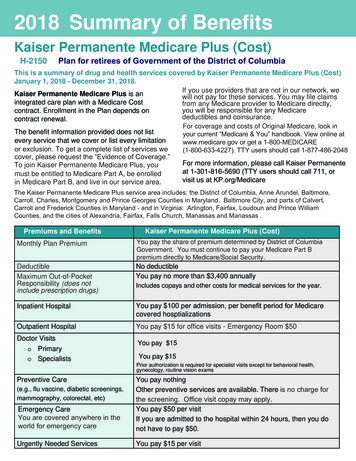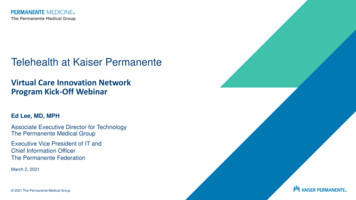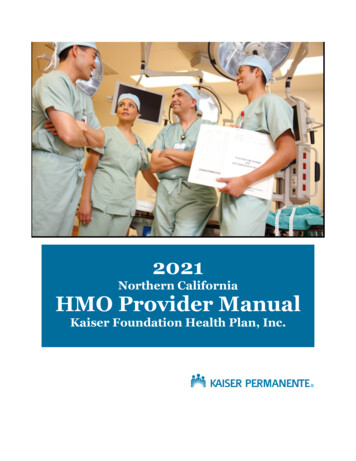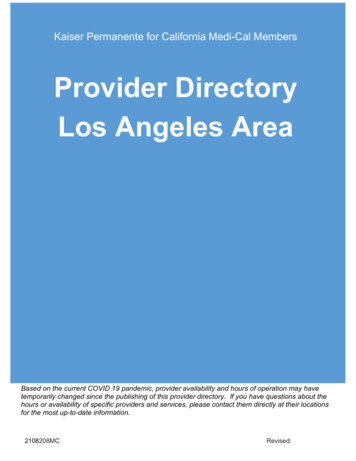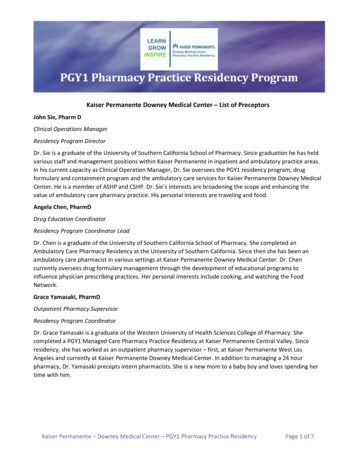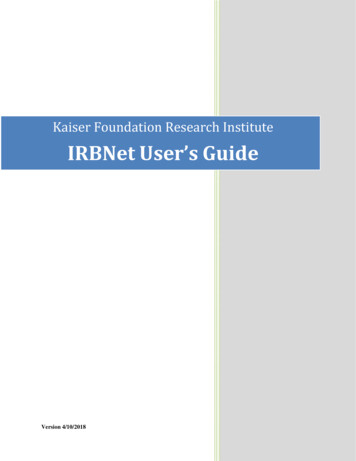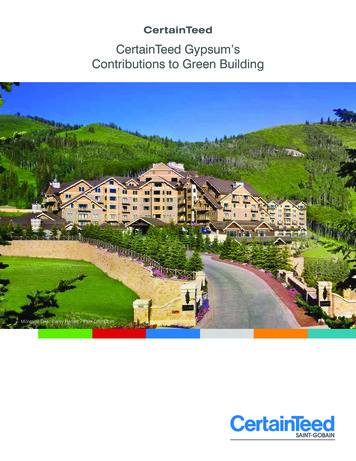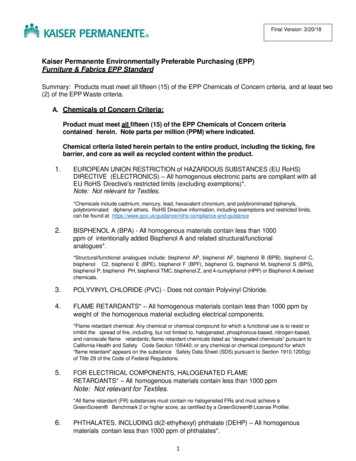
Transcription
Final Version: 3/20/18Kaiser Permanente Environmentally Preferable Purchasing (EPP)Furniture & Fabrics EPP StandardSummary: Products must meet all fifteen (15) of the EPP Chemicals of Concern criteria, and at least two(2) of the EPP Waste criteria.A. Chemicals of Concern Criteria:Product must meet all fifteen (15) of the EPP Chemicals of Concern criteriacontained herein. Note parts per million (PPM) where indicated.Chemical criteria listed herein pertain to the entire product, including the ticking, firebarrier, and core as well as recycled content within the product.1.EUROPEAN UNION RESTRICTION of HAZARDOUS SUBSTANCES (EU RoHS)DIRECTIVE (ELECTRONICS) – All homogenous electronic parts are compliant with allEU RoHS Directive's restricted limits (excluding exemptions)*.Note: Not relevant for Textiles.*Chemicals include cadmium, mercury, lead, hexavalent chromium, and polybrominated biphenyls,polybrominated diphenyl ethers. RoHS Directive information, including exemptions and restricted limits,can be found at idance2.BISPHENOL A (BPA) - All homogenous materials contain less than 1000ppm of intentionally added Bisphenol A and related onal analogues include: bisphenol AP, bisphenol AF, bisphenol B (BPB), bisphenol C,bisphenol C2, bisphenol E (BPE), bisphenol F (BPF), bisphenol G, bisphenol M, bisphenol S (BPS),bisphenol P, bisphenol PH, bisphenol TMC, bisphenol Z, and 4-cumylphenol (HPP) or Bisphenol A derivedchemicals.3.POLYVINYL CHLORIDE (PVC) - Does not contain Polyvinyl Chloride.4.FLAME RETARDANTS* – All homogenous materials contain less than 1000 ppm byweight of the homogenous material excluding electrical components.*Flame retardant chemical: Any chemical or chemical compound for which a functional use is to resist orinhibit the spread of fire, including, but not limited to, halogenated, phosphorous-based, nitrogen-based,and nanoscale flame retardants; flame retardant chemicals listed as “designated chemicals” pursuant toCalifornia Health and Safety Code Section 105440; or any chemical or chemical compound for which“flame retardant” appears on the substance Safety Data Sheet (SDS) pursuant to Section 1910.1200(g)of Title 29 of the Code of Federal Regulations.5.FOR ELECTRICAL COMPONENTS, HALOGENATED FLAMERETARDANTS* – All homogenous materials contain less than 1000 ppmNote: Not relevant for Textiles.*All flame retardant (FR) substances must contain no halogenated FRs and must achieve aGreenScreen Benchmark 2 or higher score, as certified by a GreenScreen License Profiler.6.PHTHALATES, INCLUDING di(2-ethylhexyl) phthalate (DEHP) – All homogenousmaterials contain less than 1000 ppm of phthalates*.1
*Phthalates include Di-2-ethyl hexyl phthalate (DEHP) CAS 117-81-7, Benzylbutylphthalate (BBP) CAS 8568-7, Di- n-hexyl phthalate (DnHP) CAS 84-75-3, Di-isodecyl phthalate (DIDP) CAS 68515-49-1 or 2676140-0, Dibutylphthalate (DBP) CAS 84-74-2, Diisononyl phthalate (DINP) CAS 28553-12-0 and 68515-48-0,Diisobutyl phthalate (DIBP) CAS 84-69-5, Di n-pentyl phthalate (DPENP) CAS 131-18-0, Dicyclohexyl(DCHP) CAS 84-61-7, and Di-n- hexyl phthalate (DHEXP) CAS 84-75-3 (above 1000ppm).7.PROP 65 CHEMICALS - Does not contain intentionally added chemicals listed by theState of California to cause cancer, birth defects, or reproductive harm that require warningor are prohibited from release to the environment under the California Safe Drinking Waterand Toxic Enforcement Act of 1986. (Proposition 65)*.*The Prop 65 list can be found at listIf answered “No” to Prop 65 criteria, list Chemical Abstracts Service (CAS) #'s.8.ANTIMICROBIAL / ANTIBACTERIAL AGENTS - Does not contain intentionally addedantimicrobial/antibacterial agents to reduce surface pathogens.9.ANTIMICROBIAL / ANTIBACTERIAL AGENTS – Does not contain the followingintentionally added antimicrobial/antibacterial agents for purposes of preserving theproduct:Didecyl Dimethyl Ammonium Chloride (DDAC)Diiodomethyl p-tolyl sulfoneFree of HexamethylenetetramineKathon 886 (CIT/MIT mixture)Free of Methylchlorothiazolinone (CIT,CMIT)Methylisothiazolinone (MIT)Free of N-octadecyldimethyl ammonium chlorideSilver (nano)Free of Silver sodium hydrogen zirconium phosphateSilver zinc zeolitesTriclosanZinc PyrithioneBenzisothiazolin 3-one (BIT)10.PERSISTENT, BIOACCUMULATIVE AND TOXIC CHEMICALS (PBTs) - All homogenousmaterials contain less than 1000 ppm of persistent, bioaccumulative, and toxic chemicals(PBTs)*.*PBTs include chemicals on any of the following lists: US EPA –Priority PBTs and US EPA – Priority US-EPA NW M.pdf); OSPAR – Priority PBTs & EDs & equivalentconcern riority-action); UNEP Stockholm Conv –PersistentOrganic Pollutants ofPOPs/tabid/2509/Default.aspx); USEPA – Toxics Release Inventory PBTs als-covered-tri).11.METALS - Does not contain mercury, lead, cadmium, or organotin compounds*.Note: For non-synthetic fabrics, antimony, all homogenous materials contain at or less than0.2 mg/kg.*Lead and lead-containing compounds in concentrations exceeding 40 ppm, mercury and mercury-containingcompounds exceeding 100 ppm, cadmium and cadmium-containing compounds exceeding 100 ppm,Organotin compounds [e.g. tributyltin (TBT), dibutyltin (DBT)] exceeding 100 ppm.12.PER-AND POLYFLUOROALKYL Substances (PFASs) - Product does not contain stainor water-repellant treatment that contain a per- or poly-fluorinated compound*.2
*PFASs are a category of compounds that includes long and short chain per- and poly- fluorinated alkylcompounds and fluorinated polymers. PFASs are widely used to make everyday products, including Furnitureand fabrics more resistant to stains, grease and water. This includes any compound that meets any one of thedefinitions: 13.Perfluoroalkyl substances: Compounds for which all hydrogen atoms on all carbon atoms (exceptfor carbons associated with functional groups) have been replaced by fluorine atoms.Polyfluoroalkyl substances: Compounds for which all hydrogen atoms on at least one (but not all)carbon atom have been replaced by fluorine atoms.Fluoropolymers: Carbon-only polymer backbone with fluorine atoms directly bound.Perfluoropolyethers: Carbon and oxygen polymer backbone with fluorine atoms directly bound tocarbon atoms.Side-chain fluorinated polymers: Variable composition non-fluorinated polymer backbone withfluorinated side chains.VOLATILE ORGANIC COMPOUNDS (VOCs)**Certification to meet VOC emissions limits using criteria based on the Standard Method for testing and Evaluationof Volatile Organic Compound Emissions from Indoor Sources using Environmental, or CDPH/EHLB StandardMethod V1.1 (Feb 2010) (otherwise known as California 01350 Standard). Applicable certifications and levelsinclude: GREENGUARD Gold, SCS Indoor Advantage (for BIFMA Credit 7.6.1) and SCS Indoor Advantage Gold(for BIFMA Credits 7.6.1 and 7.6.2), ANSI/BIFMA LEVEL Furniture Sustainability Standard at level 1, 2 or 3, withat least one point score for Sections 7.6, Cradle to Cradle Gold or Platinum.(For Composite wood products) - Certified to meet emissions limits set by TSCA Title IV and the CaliforniaAir Resources Board (CARB) Composite Wood Products Regulation (CA 93120 Compliant forFormaldehyde or CA Phase 2 Compliant).Product must be compliant with at least one of the four standards/certifications listed below.* VOC emissions from this product are in compliance with the concentration limits or emissions factors specified in 14.ANSI/BIFMA LEVEL Furniture Sustainability Standard at level 1, 2 or 3, with at least one point scorefor Sections 7.6Cradle to Cradle Gold or PlatinumCertified to meet UL GREENGUARD GoldCertified to meet SCS Indoor Advantage GoldWOOD USED IN FURNITURE – Must meet the Forest Stewardship Council (FSC)Controlled Wood Standard, FSC-STD-40-005 V3-1 ENi or must meet the Business Institutional Furniture Manufacturers Association ANSI/BIFMA e3-2017 FurnitureSustainability Standard, American National Standard for Bio-based renewable materials –sustainable woodii.iTheFSC Controlled Wood Standard (https://us.fsc.org/download-box.585.htm) minimizes the risk of usingwood products from ‘unacceptable’ sources in FSC-labeled products. The following types of wood and woodproducts are considered unacceptable, and are avoided in FSC-labeled products through Controlled Woodsourcing: Illegally harvested woodWood harvested in violation of traditional and civil rightsWood harvested in forests where High Conservation Values are threatened by management activitiesWood harvested from natural forests that were converted to non-forest usesWood from genetically modified trees.BIFMA e3-2017 Furniture Sustainability Standard (American Standard) for Bio-based renewable materials –sustainable wood. Wood specified in the product, other than recovered or reused wood, shall not containendangered wood species unless the trade of such wood conforms with the requirements of the Convention onInternational Trade in Endangered Species of Wild Fauna and Flora (CITES), Appendix I or II, and is harvestedaccording to the applicable laws and regulations of the country of origin. Product to be assessed shall contain atleast 50% wood by weight, by fulfilling 6.3.3.2 criteria of a minimum of 30% of the total wood product weight of theii The3
product conforms to a third-party certification program for environmentally and socially responsible forestmanagement including but not limited to, chain of custody practices throughout the supply chain; and the applicantshall make the identify of third-party certification program publicly available.15.AZO DYES**European Union Restriction on the use of certain chemical substances in textile and leather productsThe placing on the EU market of textile and leather articles containing certain chemical substances, group ofsubstances or mixtures are prohibited or severely restricted, in order to protect human health and environment,according to provisions listed on Annex XVII to Regulation (EC) No 1907/2006 of the European Parliament andof the Council (REACH Regulation) (OJ L-396 30/12/2006) (CELEX 32006R1907).According to this Regulation, the main chemical substances, group of substances or mixtures which arenot allowed in textile and leather articles are: Tris (2,3 dibromopropyl) phosphate in textile articles intended to come into contact with the skin.Tris (aziridinyl) phosphinoxide in textile articles intended to come into contact with the skin.Polybrominated biphenyls (PBB) in textile articles intended to come into contact with the skin.Mercury compounds in the impregnation of heavy-duty industrial textiles and yarn intended fortheir manufacture.Organostannic compounds:Dibutyltin (DBT) compounds in fabrics coated with polyvinyl chloride (PVC) intended foroutdoor applications.Dioctylin (DOT) compounds in textile articles, footwear or part of footwear intended to come intocontact with the skin.Nickel in articles intended to come into direct and prolonged contact with the skin, such as rivetsbuttons, tighteners, rivets, zippers and metal marks, when these are used in garments.Azodyes which may release one or more of the aromatic amines listed in Appendix 8, in textile andleather articles which may come into direct and prolonged contact with the skin or oral cavity.Nonylphenol and nonylphenol ethoxylates in textile and leather processing.List of 21 azo amines: List of aromatic amines CAS No Index No EC No Substances 1. 92-67-1 612-072-00-6 202-177-1biphenyl- 4- ylamine 4-aminobiphenyl xenylamine 2. 92-87-5 612-042-00-2 202-199-1 benzidine 3. 95-692 202-441-6 4- chloro-o-toluidine 4. 91-59-8 612-022-00-3 202-080-4 2-naphthylamine 5. 97-56-3 611006-00-3 202- 591-2 o- aminoazotoluene 4-amino-2',3-dimethylazobenzene 4-o-tolylazo-o-toluidine 6. 9955-8 202-765-8 5-nitro-o- toluidine 7. 106-47-8 612-137-00-9 203-401-0 4-chloroaniline 8. 615-05-4 210406-1 4-methoxy- m- phenylenediamine 9. 101-77-9 612-051-00-1 202-974-4 4,4'-methylenedianiline 4,4'diaminodiphenylmethane 10. 91-94-1 612-068-00-4 202-109-0 3,3'-dichlorobenzidine 3,3'dichlorobiphenyl- 4,4'-ylenediamine 11. 119- 90-4 612-036-00-X 204-355-4 3,3'-dimethoxybenzidine odianisidine 12. 119-93- 7 612-041-00-7 204-358-0 3,3'-dimethylbenzidine 4,4'-bi-o-toluidine 13. 838-88-0612-085-00-7 212-658-8 4,4'-methylenedi-o-toluidine 14. 120-71-8 204-419-1 6-methoxy-m-toluidine pcresidine 15. 101-14-4 612- 078-00-9 202-918-9 4,4'- methylene-bis-(2-chloro-aniline) 2,2'-dichloro-4,4'methylene-dianiline 16. 101-80- 4 202-977-0 4,4'- oxydianiline 17. 139-65-1 205-370-9 4,4'-thiodianiline18. 95-53-4 612-091-00-X 202-429- 0 o-toluidine 2- aminotoluene 19. 95-80-7 612-099-00-3 202-453-1 4methyl-m-phenylenediamine 20. 137- 17-7 205-282-0 2,4,5-trimethylaniline 21. 90-04-0 612-035-00-4201-963-1 o-anisidine 2-methoxyaniline 22. 60-09-3 611-008- 00-4 200-453-6 4-amino azobenzene--B. Waste CriteriaProduct must meet two (2) of the EPP Waste criteria contained herein.1.DOES NOT CREATE A HAZARDOUS WASTE (PRODUCT) - Product is not regulatedas a state or federal hazardous waste when used for its intended purpose.2.20% OR MORE POST-CONSUMER RECYCLED CONTENT (PRODUCT) –4
Product contains 20% or more of post-consumer recycled content (excludes steel).3.RECYCLABILITY (PRODUCT) - Product is Recyclable*.*A product or package is recyclable if it can be collected, separated, or otherwise recoveredfrom the waste stream through an established recycling program for reuse or use inmanufacturing or assembling another item, with recycling facilities for the item available to atleast 60 percent of communities where the item is sold.4.RECYCLED CONTENT (PRIMARY PACKAGING) - Primary Packaging - Containsmore than 10% post-consumer recycled content.5.RECYCLED CONTENT (SECONDARY PACKAGING) - Secondary Packaging Contains more than 30% post-consumer recycled content.6.FOREST STEWARDSHIP COUNCIL - Packaging has received ForestStewardship Council Certification*.*Packaging has one of the following certifications: 100% - From well-managed forests; Mix - Fromresponsible sources; Recycled - Made from recycled material.7.CONSUMER FRIENDLY RECYCLING LABELS - Packaging is labeled withHow2Recycle Label System.**How2Recycle is a standardized labeling system that clearly communicates recycling instructions to thepublic. More information available at how2recycle.org. RIC code not sufficient to meet this criterion.8.RECYCLABILITY (PACKAGING) - Packaging is Recyclable*.*A product or package is recyclable if it can be collected, separated, or otherwise recovered from the wastestream through an established recycling program for reuse or use in manufacturing or assembling anotheritem, with recycling facilities for the item available to at least 60 percent of communities where the item issold.Written in collaboration.5
Kaiser Permanente Environmentally Preferable Purchasing (EPP) Furniture & Fabrics EPP Standard Summary: Products must meet all fifteen (15) of the EPP Chemicals of Concern criteria, and at least two . endangered wood species unless the trade of such wood conforms with the requirements of the Convention on International Trade in Endangered .
